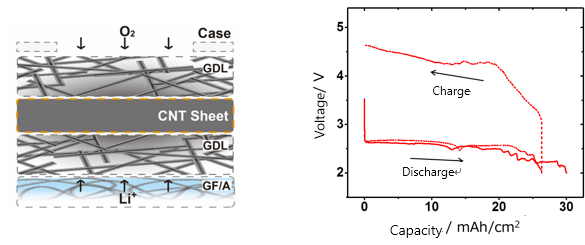Development of Ultra-High Capacity Lithium-Air Batteries Using CNT Sheet Air Electrodes
—15 Times Greater Capacity Than Lithium-Ion Batteries, the New Battery May Enable Electric Vehicles to Drive as Far as Conventional Vehicles—
2017.04.05
National Institute for Materials Science (NIMS)
Japan Science and Technology Agency (JST)
A NIMS research team developed lithium-air batteries with very high electric storage capacity—15 times greater than the capacity of conventional lithium-ion batteries—using carbon nanotubes as an air electrode material.
Abstract
- A NIMS research team led by Yoshimi Kubo and Akihiro Nomura, team leader and researcher, respectively, Lithium Air Battery Specially Promoted Research Team, C4GR-GREEN, developed lithium-air batteries with very high electric storage capacity—15 times greater than the capacity of conventional lithium-ion batteries—using carbon nanotubes (CNT) as an air electrode material.
- Demand for rechargeable batteries is expected to increase rapidly as electric vehicle power sources and joint sources of household electricity with solar cells. The current lithium-ion batteries have advantages of being compact, producing high voltages, and having long life, but they also have an issue in that their energy densities, which represent electric storage capacities, have nearly reached a limit. Lithium-air batteries have great potential in overcoming this issue. The lithium-air battery is the “ultimate rechargeable battery” with the highest energy density in theory. The battery may have drastically large capacity and reduce production cost. However, conventional battery research usually focuses on basic studies of battery reactions using small amounts of materials, and therefore is not designed to demonstrate large battery capacities using cells of actual size and shape.
- The research team recently achieved very high electric storage capacity of 30 mAh/cm2 using realistic cell forms. This value represents about 15 times greater capacity compared to the capacity of conventional lithium-ion batteries (about 2 mAh/cm2). This achievement was made by using CNTs as an air electrode material and thereby optimizing the electrode’s microstructure. We think that the battery’s large capacity can be attributed to CNTs’ large surface area and flexible structure. It is unlikely that existing knowledge can explain the capacity increase seen in this study, and these findings may stimulate discussion over lithium-air battery reaction mechanisms.
- In light of these results, we aim to develop genuinely high-capacity lithium-air batteries at the practical level by exploring techniques to increase energy density in cell layers, called a stack, and remove impurities from the air.
- This study was supported by JST’s ALCA-SPRING program, and conducted in conjunction with the MEXT-commissioned projects titled “Development of environmental technology using nanotechnology” (until FY2015) and "Integrated materials development project" (from FY2016). In addition, a part of this study was supported by a FY2015 research grant from Iketani Science and Technology Foundation.
- This study will be published in Scientific Reports at 10 a.m. on April 5, 2017, GMT.

Figure. Conceptual diagram of a CNT sheet air electrode (left) and charge-discharge characteristics of the lithium-air battery with ultra-high capacity (right).
Related files
- Center for Green Research on Energy and Environmental Materials
- GREEN
Contacts
(Regarding this research)
-
Yoshimi Kubo
Leader of the Lithium Air Battery Specially Promoted Research Team, C4GR-GREEN, NIMS
Tel: +81-29-860-4773
E-Mail: KUBO.Yoshimi=nims.go.jp
(Please change "=" to "@")
(Regarding JST activities)
-
Hideki Yoshida
ALCA Group, Department of Green Innovation, Japan Science and Technology Agency
K's Gobancho, 7 Gobancho, Chiyoda-ku, Tokyo 102-0076, Japan
Tel: +81-3-3512-3543
Fax: +81-3-3512-3533
E-Mail: alca=jst.go.jp
(Please change "=" to "@")
(For general inquiries)
-
Public Relations Office
National Institute for Materials Science
1-2-1 Sengen, Tsukuba, Ibaraki 305-0047, Japan
Tel: +81-29-859-2026
Fax: +81-29-859-2017
E-Mail: pressrelease=ml.nims.go.jp
(Please change "=" to "@") -
Public Relations Division
Japan Science and Technology Agency
5-3 Yonbancho, Chiyoda-ku, Tokyo 102-8666, Japan
Tel: +81-3-5214-8404
Fax: +81-3-5214-8432
E-Mail: jstkoho=jst.go.jp
(Please change "=" to "@")
